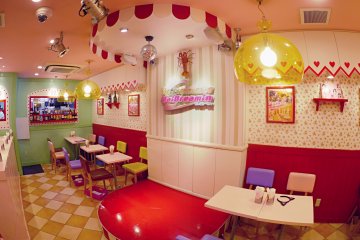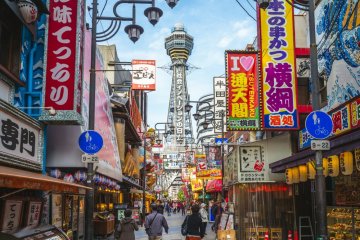
Le Sanctuaire Sumiyoshi-taisha
Hannah SySumiyoshi-taisha est l'un des plus anciens sanctuaires du Japon, et le plus célèbre des sanctuaires Sumiyoshi.

Sumiyoshi Taisha, also known as Sumiyoshi Grand Shrine, is one of the most famous shrines in Osaka and one of the oldest in Japan. During hatsumode, the first shrine visit of the new year, over two million people visit this unique shrine. The shrine grounds are a picture of tranquility with vermillion shrine buildings, natural beauty, and glimmering water.
History
Sumiyoshi Taisha is cited in two of Japan’s oldest books, the Kojiki and the Nihon Shoki, as well as one of the world’s oldest stories, Tale of Genji. Legend has it that Sumiyoshi Taisha was founded in 211 CE by Empress Jingu who dedicated it to the Sumiyoshi Sanjin, which is a collective name for the three Shinto gods of the sea and later, waka poetry. Although landlocked now, the shrine used to overlook the ocean. Later, Empress Jingu was also enshrined on the grounds. This act linked the shrine to her son, Emperor Ojin, who was deified as Hachiman, god of war. With the enshrinement of various kami (gods), the shrine is a popular place to pray for a variety of reasons, including safe seas, travel, poetry, fighting (such as martial arts), military, and general health and prosperity.
Sumiyoshi Taisha is the head shrine of over two thousand Sumiyoshi shrines across Japan.
One-of-a-kind architecture
Interestingly, Sumiyoshi Taisha was founded before the introduction of Buddhism in Japan, giving it a unique architectural style called Sumiyoshi-zukuri, which is free of influence from the Asian mainland. This purely Japanese style is registered as a national treasure and characterized by straight roofs, rather than curved ones, decorated with forked finials that resemble crossed poles, and five horizontal billets. The shrine’s four main halls are painted vermillion and surrounded by fences.
Explore the shrine
Sumiyoshi Taisha is home to dozens of shrine buildings, which are complemented by torii gates, rich nature, and stone lanterns. Stroll through the sacred grounds and allow the peaceful energy to rejuvenate your mind and body.
Sumiyoshi Taisha is a 3-minute walk from Sumiyoshi Taisha Station on the Nankai Main Line or Sumiyoshitorii-Mae Station on the Hankai Tramline.

Sumiyoshi-taisha est l'un des plus anciens sanctuaires du Japon, et le plus célèbre des sanctuaires Sumiyoshi.

Lors du festival annuel de plantation du riz du sanctuaire Sumiyoshi, qui se déroule à Osaka le 14 juin, le Japon réaffirme le lien étroit qu'il entretient avec son agriculture de base.

De prime abord, l'hôtel Sheraton Miyako à Osaka ne paie pas de mine, mais le service qui y est proposé est de très haute qualité. Très bien situé, à deux pas de Namba et de Tsuruhashi, des navettes au départ de l'hôtel vous permettent de rejoindre facilement l'aéroport d'Itami ou l'aéroport du Kansai.

Wooden House : un café charmant et convivial situé dans un quartier calme d'Osaka.

Le Maidreamin Maid Café est un salon de thé situé dans le quartier de DenDen Town, près de la gare de Namba à Osaka.

Parmi les spécialités culinaires du Kansai, la région où se trouve Osaka, on retrouve l'okonomiyaki, une délicieuse crêpe épaisse salée. A l'occasion, goûtez donc à un okonomiyaki préparé par un des cuisiniers des restaurants Fukutarō, et vous m'en direz des nouvelles!

L'Abenobashi Terminal Building est une installation commerciale polyvalente située dans l'arrondissement Abeno-ku, à Osaka. Le bâtiment abrite non seulement de nombreux magasins, mais aussi un hôtel et le bureau de vente du fabricant japonais d'électronique Sharp Corporation. Le nom de ce gratte-ciel est Abeno Harukas, dérivé du vieux japonais Harukasu qui signifie «éclairer» ou «illuminer». La construction du bâtiment a commencé en 2010 et il a été inauguré le 7 mars 2014. Avec une hauteur de 300 mètres et 62 étages, Abenobashi Terminal Building est le plus haut gratte-ciel du Japon.

Ten-Shiba est la zone d'entrée du parc Tennoji, qui a été converti en zone de loisirs pour les habitants d'Osaka en octobre 2015. La zone est aménagée autour d'une grande pelouse et entourée d'un grand nombre d'installations pour la population locale. Vous pourrez y faire bien plus qu'une promenade dans le parc - Ten-Shiba abrite pas moins de trois terrains de football en salle où tout le monde peut jouer, de nombreux cafés et restaurants, un magasin de fleurs, un parc pour animaux de compagnie et une aire de jeux pour les plus petits. Il y a aussi un Conbini au cas où vous auriez besoin d'un rafraîchissement tout en profitant au maximum de votre temps dans le parc. En 2016, le parc repensé a remporté l'un des Good Design Awards annuels du Japon. L'entrée est entièrement gratuite et le wifi gratuit est disponible pour les visiteurs.

Tsutenkaku Tower, standing at 103 meters tall, is an unmistakable symbol of Osaka and located in the Shinsekai area. The towering 8-sided structure’s facade is characterized by its exposed steel beams and Eiffel Tower-esque appearance. Visitors and residents alike flock to its observation deck for stunning panoramic views of the area. History Tsutenkaku, originally built in 1912 at 63 meters tall, was renowned for its impressive height, making it one of the tallest structures in Asia at the time. The structure’s appearance was modeled after famous French architecture, with the tower portion matching the Eiffel Tower and the base reminiscent of the Arc de Triomphe. The tower was erected as a centerpiece of the bustling area and was attached to the popular amusement park, Luna Park, via a cable car. Unfortunately, the tower was damaged in 1943 by a fire and later dismantled for its steel during WWII. Years later in 1956, after locals campaigned for a new tower, the current Tsutenkaku was constructed at a taller 103 meters tall and designed by famous architect Tachu Naito, who also designed Tokyo Tower. You can view photos, videos, and a diorama of the original tower and Luna Park on Tsutenkaku’s third floor. Today Presently, Tsutenkaku stands as a beacon of the lively area and is a must see spot if you are visiting the Shinsekai. During the day, the structure stands silver against the sky, while at night it shines bright neon thanks to its numerous LED lights that change color with the seasons. The tower is open year-round from 10:00 to 20:00 with admission until 19:30. General observatory tickets cost 900 JPY for adults (high school students and above) and 400 JPY for infants 5 years old and over and junior high and elementary school students. For an additional 300 JPY (adults) or 200 JPY (children and young adults), you can visit Tenbo Paradise and Tip The Tsutenkaku. Listed below are some highlights to help guide your adventures. Explore the Surrounding Area While in the area, be sure to check out the Shinsekai neighborhood for its local wares, delicious eats, and lively atmosphere. Stroll along JanJan Yokocho (JanJan Alley), a covered shopping street, and enjoy the clothes stores, arcade games, and kushikatsu restaurants, which are known for their fried skewers of breaded meat and vegetables. The street is also populated by multiple Shogi, Japanese chess, salons. For a break from the bustling Osaka streets, visit nearby Tennoji Park for a relaxing walk.